Unlock Your Marketing Potential with These 5 Essential Google Analytics Reports
Mastering Google Analytics 4 (GA4) is crucial for businesses seeking to make data-driven decisions and develop marketing strategies that resonate with audience behavior. Although newcomers may find GA4’s interface and terminology overwhelming, it’s important to persevere. By gaining a comprehensive understanding of GA4, you can uncover insights that will significantly improve your grasp of customer interactions. Once you become proficient in utilizing its features and interpreting its data, GA4 will provide invaluable insights into your customer base, empowering you to tailor your marketing initiatives effectively. Let’s explore five indispensable GA4 reports that can elevate your marketing strategies to new heights.
1. Traffic Acquisition Report: Discover the Sources Driving Your Website Traffic
Have you ever wondered where your website traffic originates? The Traffic Acquisition report is your gateway to unveiling this critical information. This insightful report categorizes the various channels that funnel visitors to your site, enabling you to pinpoint essential marketing pathways such as organic search, paid advertising, social media, and referrals. By thoroughly analyzing these channels, you can gain a clearer understanding of your audience’s origins, which allows you to strategically focus your marketing efforts for optimal impact.
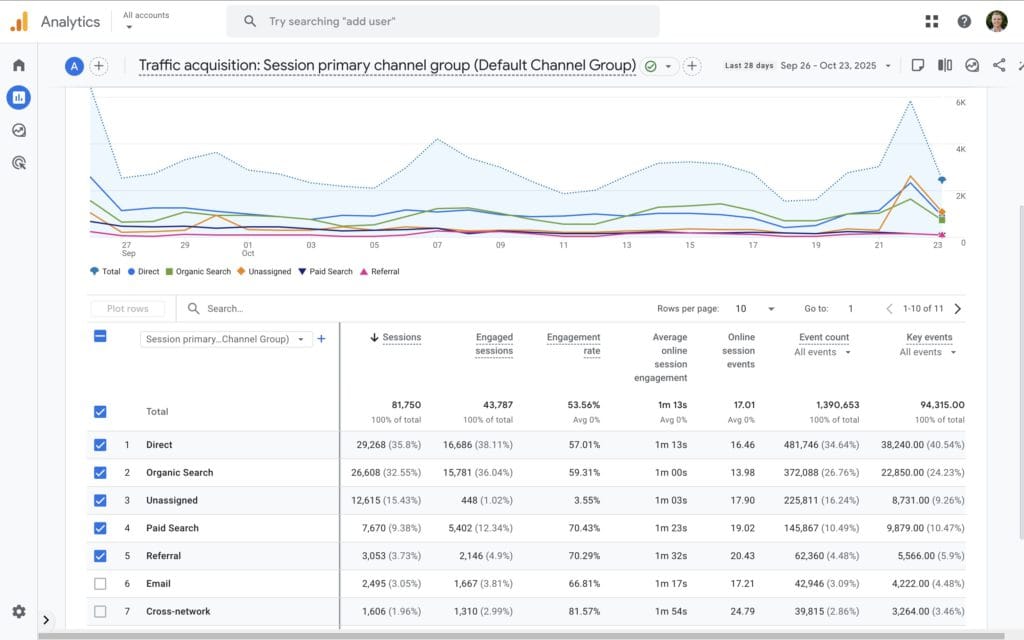
Strategies to Maximize the Traffic Acquisition Report:
- Identify Your Top-Performing Channels: Analyze which platforms are delivering the highest number of visitors to your site. If you discover that organic search is leading the charge, consider increasing your investment in SEO efforts to build upon this success.
- Evaluate Traffic Quality: Concentrate not just on the quantity of traffic but also on quality metrics like sessions per user and average engagement time to better gauge visitor interest and commitment.
- Optimize Your Marketing Budget: Distribute your budget wisely among channels that not only draw visitors but also engage them effectively, fostering repeat visits.
By understanding where your audience is coming from, you can shift your marketing focus to prioritize the channels that yield the most favorable results. The report automatically illustrates the various ways users access your website, but its effectiveness can be further amplified by tagging your inbound marketing campaigns. This approach is particularly important when distributing newsletters or executing advertising campaigns designed to drive traffic to your site.
Maximize Your Google Analytics Tracking with Campaign Tagging URLs
Campaign-tagged URLs are specially crafted links to your website that incorporate additional tracking information known as query parameters. These parameters enable Google Analytics to track your marketing efforts with heightened accuracy. By appending these parameters to your URLs, you unlock detailed insights into how visitors arrive at your site, providing data that extends beyond standard reports.
The Significance of Campaign Tagging URLs:
- Track Individual Marketing Campaigns: These URLs allow you to pinpoint which specific marketing initiatives are effectively driving traffic to your website.
- Understand Your Traffic Sources: Gain clarity on the origins of your visitors, whether they come from a newsletter, a social media post, or a paid advertisement.
- Measure Campaign Effectiveness: By analyzing data derived from tagged URLs, you can identify your most successful campaigns and adjust your strategies accordingly.
How Campaign Tagging URLs Enhance Acquisition Reports:
Typically, Google Analytics categorizes traffic sources into organic search, direct, referral, and organic social. While this categorization provides a foundational understanding, it lacks the granularity necessary to extract insights into specific campaigns or links.
Implementing Campaign Tagging in Your URLs:
To effectively utilize campaign-tagged URLs, you need to append specific parameters to your inbound links. The key parameters include:
- utm_source – identifies your traffic source, such as a newsletter, Facebook, or Google.
- utm_medium – specifies the marketing medium, whether it’s email, social media, or cost-per-click (CPC).
- utm_campaign – denotes the specific campaign name, such as ‘spring sale’ or ‘product launch’.
- utm_term (optional) – primarily used for paid search campaigns to identify specific keywords.
- utm_content (optional) – differentiates similar content or links within the same advertisement or campaign.
For example, here is a Tagged URL:
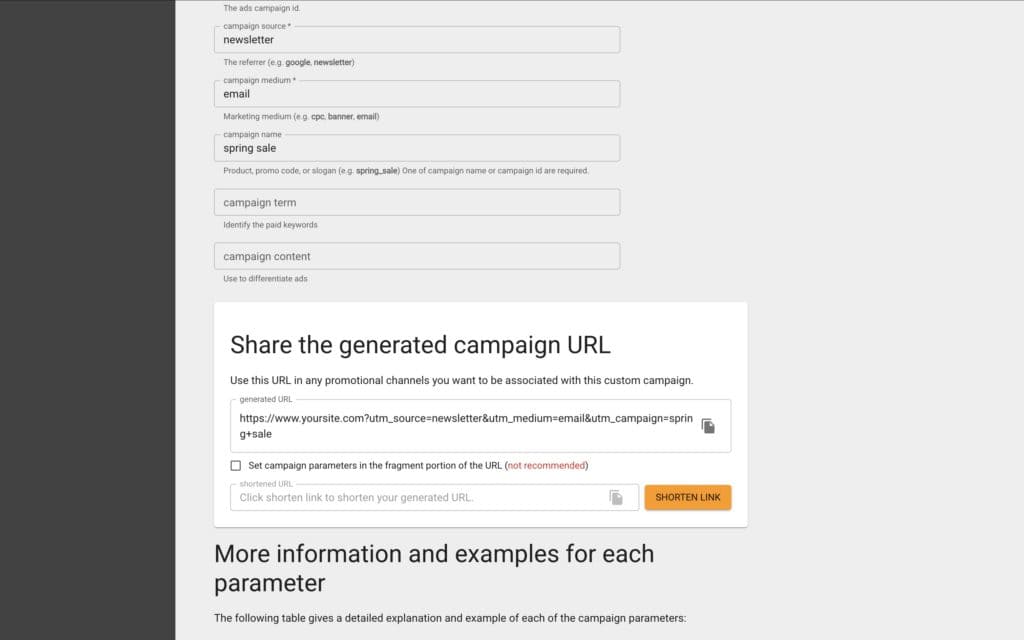
When a user clicks on this link, Google Analytics captures the parameters, allowing you to ascertain that the visitor originated from your “spring sale” campaign via an email newsletter. By modifying your inbound links with campaign tags, you can accurately track how users discover your website.
In addition to creating campaign-tagged URLs, connecting your Google Ads account with Google Analytics can be extremely beneficial. You can view a tutorial video that walks you through this process:
2. Engagement Reports: Analyze User Interaction on Your Website
Attracting traffic to your site is only one aspect of the equation. The Engagement Reports deliver essential insights into user behavior once they arrive. Do they linger and explore, or do they exit promptly? Which pages capture their attention and encourage deeper interaction?
Within the Engagement section, the Pages and Screens report provides a comprehensive overview of all the pages users have interacted with on your website. This report allows you to identify both your most engaging and least captivating content. Key metrics to monitor include:
- Views: The total number of times your pages have been accessed, offering quick insight into which content resonates most with users.
- Views Per Active User: This metric reveals which content users revisit, indicating high levels of interest or value.
- Key Events: Monitor actions on specific pages, such as purchases, sign-ups, or other conversions. Setting up key events enables you to evaluate how effectively certain pages drive user actions and align with your business goals.
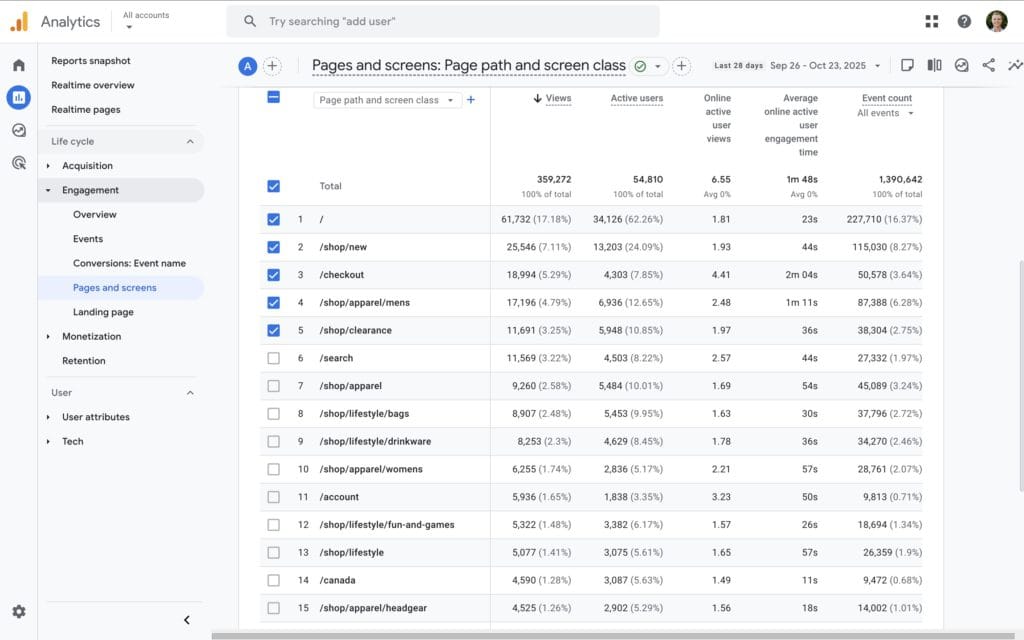
Utilize These Insights to Elevate Your Website:
- Enhance High-Performing Content: If certain blog posts or product pages attract high engagement, consider producing more similar content to sustain that interest.
- Improve Low-Engagement Pages: Identify pages with high bounce rates and implement strategic changes to boost engagement, such as clearer calls to action or more compelling visuals.
- Personalize User Experience: Ensure that navigation is intuitive and content is relevant to keep visitors exploring your website longer.
Prioritizing user engagement is essential; your objective should not solely be to increase page views but to cultivate connections that convert visitors into leads and customers for your business.
3. Funnel Exploration Report: Strategically Map and Optimize User Journeys
Understanding how users navigate your website is crucial for boosting conversion rates. The Funnel Exploration report in GA4 enables you to visualize the steps users take to achieve specific goals, such as completing a purchase or signing up for a newsletter. This report helps identify where users drop off during the conversion process, providing insights for optimizing each stage to enhance the user experience.
Steps to Create a Funnel Exploration Report in GA4:
- Navigate to the ‘Explore’ section of GA4.
- Click ‘Blank’ to initiate a new report.
- Select ‘Funnel Exploration’ from the drop-down menu under ‘Technique’.
Step 2: Define Your Funnel Steps
- Click the pencil icon next to ‘Steps’ to outline your funnel.
- Add a step for each stage in your user journey and assign it a clear name (e.g., ‘Visited Homepage’, ‘Viewed Product’, ‘Added to Cart’, ‘Completed Purchase’).
- For each step, select the event or page view that corresponds to that action.
For example:
- Visited Homepage: Event name equals ‘page_view’ where page path equals ‘/’.
- Viewed Product: Event name equals ‘view_item’.
- Added to Cart: Event name equals ‘add_to_cart’.
- Completed Purchase: Event name equals ‘purchase’.
- After defining all steps, click ‘Apply’ to finalize your funnel.
Step 3: Customize Your Funnel (Optional)
- Decide whether you want an ‘Open Funnel,’ allowing users to enter at any step, or a ‘Closed Funnel,’ where users must start at the first step.
- Set an optional timeframe for how long users have to complete the funnel.
- Add filters to focus on specific user criteria as needed.
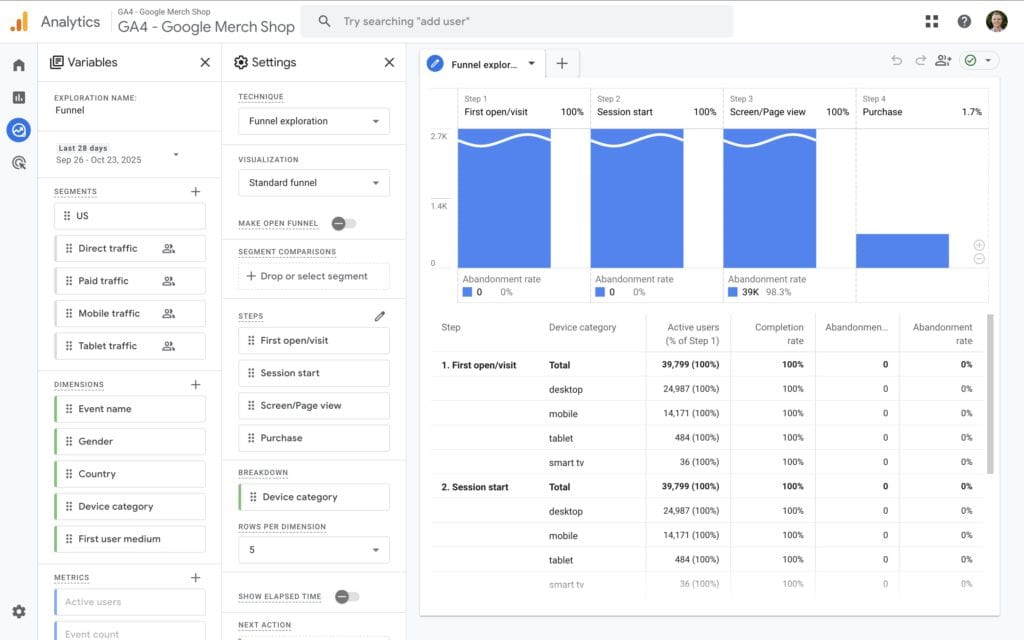
Maximize the Benefits of This Report By:
- Optimizing Conversion Steps: Evaluate each funnel stage to uncover opportunities for enhancement. If a significant number of users exit during a specific step, consider simplifying the process or offering more guidance to assist them.
- Enhancing User Experience: Utilize insights from the funnel report to create a more intuitive user journey. This may involve redesigning pages, improving load times, or refining calls to action.
- Testing and Iterating: Conduct A/B tests across funnel stages to determine which changes lead to higher conversion rates. Continuous testing is vital for refining the process over time.
- Personalizing Content: Tailor the user experience based on segment behavior. For instance, if mobile users drop off at a specific point, optimize that step for mobile devices to enhance their experience.
Utilizing the Funnel Exploration report allows you to create a more streamlined and effective path to conversion. By identifying and addressing weaknesses within your funnels, you can refine the process and effectively guide users toward your desired outcomes.
4. Demographic Details Report: Gain Profound Insights About Your Audience
The Demographic Details report provides invaluable insights into your audience’s age, gender, location, and interests. This information is critical for customizing your content and campaigns to connect better with your target audience, ultimately driving increased engagement and conversions.
Key Focus Areas in the Demographic Report:
- Age and Gender Analysis: Discover the age ranges and gender distribution of your audience to tailor your messaging more effectively.
- Geographic Distribution: Identify the locations of your users to enhance regional marketing efforts and strategically time your campaigns.
- Interests and Affinity Categories: Understand your users’ interests beyond your website to create content that captivates and engages them effectively.

Effective Strategies Based on Demographic Insights:
- Personalize Your Content: Develop content and marketing messages that align seamlessly with the preferences of your primary demographic segments to enhance relevance.
- Implement Targeted Advertising: Use demographic data to refine your ad targeting, ensuring your promotions reach the most receptive audience possible.
- Expand Your Market Reach: Identify underrepresented demographics that present growth opportunities and strategize to engage these potential users effectively.
By focusing on demographic insights, you can create marketing campaigns that are not only more relevant but also more effective in connecting with your audience’s specific needs and preferences.
5. Monetization Report: Gain Valuable Insights into Your Revenue Streams
For websites that generate revenue, the Monetization reports are indispensable. These reports deliver a comprehensive overview of how users contribute to your financial success, allowing you to make strategic decisions based on concrete data.
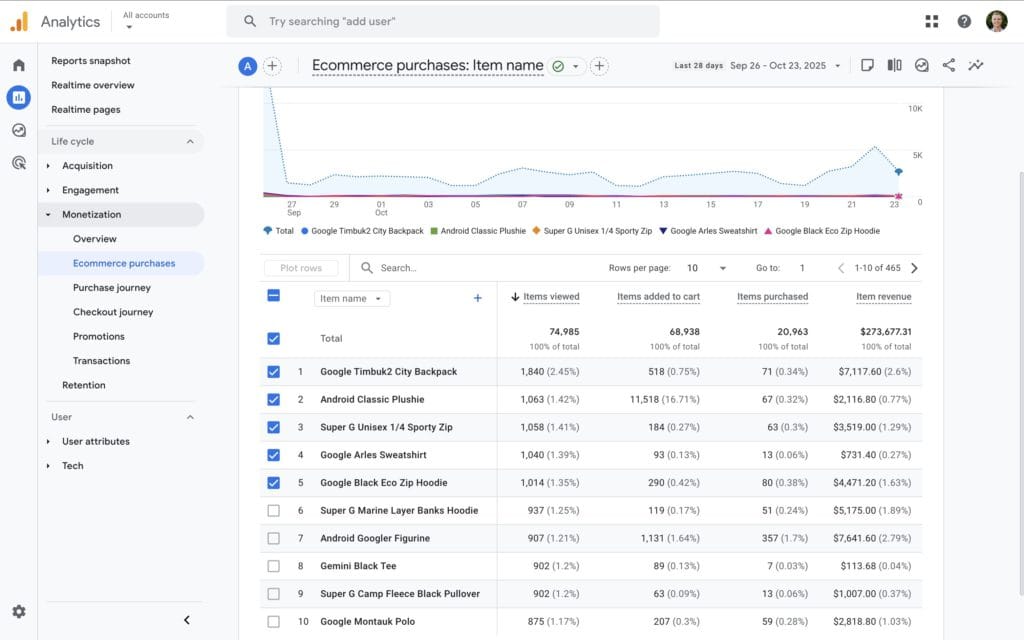
Essential Metrics to Track for Financial Success:
- Total Revenue: The cumulative income generated over a specified period, providing a clear view of your financial performance.
- Average Purchase Revenue: The average revenue generated per transaction, which helps assess overall profitability and effectiveness.
- Purchases: Track the frequency and types of products or services sold to gain insights into customer preferences and buying behavior.
Utilize This Data to Boost Your Revenue Effectively:
- Identify Your Best-Selling Products: Focus your marketing efforts on products that yield the highest revenue for your business.
- Enhance Product Promotion: Increase the visibility and attractiveness of your products to drive sales and enhance revenue generation.
- Leverage Upselling and Cross-Selling Opportunities: Utilize purchasing data to recommend complementary products, thereby increasing the average order value and improving customer satisfaction.
A comprehensive understanding of your monetization metrics empowers you to make informed decisions that enhance your profitability and promote overall business growth.
Take Action and Master Google Analytics Today
By familiarizing yourself with these five essential GA4 reports, you are establishing a solid foundation for marketing success driven by data-informed insights. When you’re ready to deepen your expertise in Google Analytics, consider enrolling in a Google Analytics 4 Course to learn how to leverage these reports effectively and maximize this crucial business tool for your advantage.
Remember, successful marketing is not just about attracting visitors; it’s equally about understanding their needs and behaviors. Utilize the reports discussed here to gain deeper insights into your audience, refine your strategies, and watch your marketing initiatives thrive.
The post 5 Google Analytics Reports Every Marketer Should Know About appeared first on Ezi Gold.
The Article Essential Google Analytics Reports Every Marketer Needs Was Found On https://limitsofstrategy.com


No responses yet